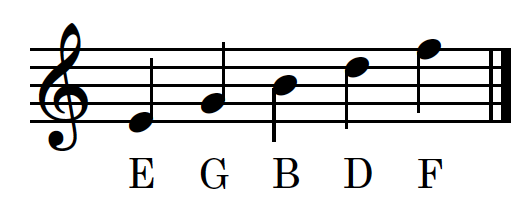Theory I: Pitch
Here is a pdf of the material that I will be adding to the page soon.
Pitch.pdfThe Staff
The staff is the basis for western music notation. It is essentially a graph in which the X axis represents time, and the Y axis represents relative pitch. In the example above, we can see that the first note (C5) is higher than the fourth note (G), and that it happens earlier in time, since the C is to the left of the G. We will speak more of time in the chapter on rhythm.

The Grand Staff
The Grand Staff is two staves connected by a brace. It typically uses the two most common Clefs (treble and bass) and is often used by instruments with wide ranges, such as keyboard instruments and some tuned percussion instruments.
In the above below, you see the two symbols at the beginning of each staff. These are called clefs and they tell you what notes to play. Before we can understand pitch, we need to know where these pitches reside on the staff.
The Treble Clef looks like an elaborate G, and is called the G clef. However, it's called the G clef because the G line (second line up) is the only line crossed 4 times. This identifies where G4 is (more on numberings when we talk about middle C and octaves).
The Bass Clef looks kind of like a backwards C, and is called the F clef. The two dots after it surround the note F3, which is the 4th line up. If you look at the third note in the bass clef, this note is on it's own line (a ledger line), and it is the note directly between the two staves. This is called Middle C (C4). If you wrote this note in treble clef, it would be one line below the treble staff.

In the example below, we now know the notes F3 (F below middle C), G4 (G above middle C) and C4 (the line between the two staves). from here, we can start to find the other notes on the staff. Below is a grand staff labeling every note. Over time you will memorize this just from frequent use. It is important that you first attain accuracy, and then with accuracy, speed.

The Notes on the Staff

A good way to quickly learn the notes on the staff is using a mneumonic. A common one for the lines of the treble staff is Every Good Boy Does Fine. There are others you can create that might work better for you.

The spaces are easier because they spell out the word FACE.

For the lines of the bass staff, a common mneumonic is Good Boys Deserve Fudge Always (Some of these seem to be ignoring girls, see if you can come up with one that is more inclusive!).

For Bass Clef, the common mneumonic for spaces is simple: All Cows Eat Grass, which is not only easy, but true!

Accidentals are symbols that indicate to raise or lower a note, usually by a half-step. In the example to the side, the G is followed by G-sharp, which is a half step higher than G. The A is followed by A-flat, which is a half step lower than A. The A-flat is then followed by A-natural, which returns the note to A.

The two in the staff below alter the notes by a two half-steps. These are called, respectively, double-sharp and double-flat.

Ledger lines are used to extend the staff above or below. You just continue counting notes as needed.
